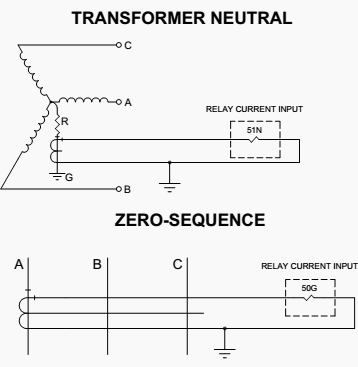
Applications and Characteristics Of Overcurrent Relays (ANSI 50, 51)
50/51 and 50/51N relays
Overcurrent relays are the most commonly-used protective relay type. Time-overcurrent relays are available with various timing characteristics to coordinate with other protective devices and to protect specific equipment. Instantaneous overcurrent relays have no inherent time delay and are used for fast short-circuit protection.
Figure 1 below shows the timing characteristics of several typical 51 time-overcurrent relay curve types, along with the 50 instantaneous characteristic.

Figure 1 – ANSI 50 and 51 overcurrent relay characteristics
The pickup level is set by the tap setting, which is usually set in CT secondary amperes but may be set in primary amperes on some microprocessor-based relays.
In Figure 1, the time dial settings are different to give enough space between the curves to show their differences.
The above are IEEE-standard curves; others are available, depending upon the relay make and model. A solid state electronic or microprocessor-based relay will have all of these curves available on one unit; electromechanical relays must be ordered with a given characteristic that cannot be changed.
The 50 instantaneous function is only provided with a pickup setting. The 30ms delay shown in figure 1 for the 50 function is typical and takes into account both the relay logic operation and the output contact closing time.
Most microprocessor-based units will also have an adjustable delay for the 50 function; when an intentional time delay is added the 50 is referred to as a definite-time overcurrent function. On solid-state electronic and microprocessor-based relays, the 50 function may be enabled or disabled.
On electromechanical relays, the 50 function can be added as an instantaneous attachment to a 51 time-overcurrent relay. If a relay has both 50 and 51 functions present and enabled is referred to as a 50/51 relay.
Typically, overcurrent relays are employed as one per phase. In solidly-grounded medium voltage systems, the most common choice for ground fault protection is to add a fourth relay in the residual connection of the CT’s to monitor the sum of all three phase currents. This relay is referred to as a residual ground overcurrent or 51N (or 50/51N) relay.
The CT arrangement for 50/51 and 50/51N relays for a solidly-grounded system is shown in Figure 2 below.

Figure 2 – Overcurrent relay arrangement with CT’s, including 50/51N
For a low-resistance-grounded system, the use of an overcurrent relay connected to a CT in the service transformer or generator neutral is usually the best option. This CT should have a ratio smaller than the phase CT’s, and the relay pickup range in conjunction with the neutral CT should allow a pickup as low as 10% of the neutral resistor rating.
For a feeder circuit downstream from the service transformer, a zero-sequence CT is recommended, again with a ratio small enough to allow a pickup as low as 10% of the neutral resistor rating.
When an overcurrent relay is utilized with a zero-sequence CT it is referred to as a 50G, 51G or 50/51G relay depending upon relay type used. Figure 3 shows typical arrangements for both these applications.

Figure 3 – Transformer neutral and zero-sequence ground relaying applications for resistance-grounded systems
For ungrounded systems, the ground detection methods are recommended since little ground current will flow during a single phase-to-ground fault. Low voltage solidly-grounded systems are discussed below.
The typical application of phase and residual neutral ground overcurrent relays in one-line diagram form is shown in figure 4.

Figure 4 – Typical application of overcurrent relays
In Figure 4, the designation 52 is the IEEE Std. C37.2-1996 designation for a circuit breaker.
The phase relays are designated 51 and the residual ground overcurrent relay is designated 51N (both without instantaneous function). The bracketed denotes that there are three phase overcurrent relays and three CT’s. The dotted line from the relays to the circuit breaker denotes that the relays are wired to trip the circuit breaker on an overcurrent condition.
The 51C relay does not operate on overcurrent unless the voltage is below a preset value. The 51 V relay pickup current shifts as the voltage changes, allowing it to only respond to overcurrents at reduced voltage. Both require voltage inputs, and thus require voltage transformers for operation.
OverCurrent Protection and Coordination (VIDEO)
Cant see this video? Click here to watch it on Youtube.
Reference: System Protection - Bill Brown, P.E., Square D Engineering Services